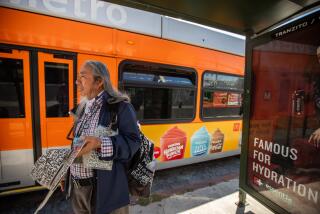‘Now I Can Walk Straight’
- Share via
Fitted with a brand new prosthetic leg from Shriners Hospitals for Children, a smiling 14-year-old South Korean girl left Los Angeles for home Tuesday, brimming with hope of leading a normal life.
“I feel very good,” said Young-Ran Kim after celebrating with Korean barbecued short ribs and kimchi on the eve of her departure. “Now I can walk straight, like other people.”
Young-Ran had suffered from a congenital condition that had fractured her tibia and not allowed it to heal, physicians said. She had walked with a leg brace and efforts to treat her in South Korea had failed.
But thanks to a cooperative effort of Shriners Hospital in Los Angeles and the Choongchung-namdo provincial government, Young-Ran’s family didn’t pay a cent for the treatment, travel and lodging in Southern California. Shriners Hospitals provided free medical care and the provincial government paid for airfare and lodging for her and her mother.
Soon after Young-Ran’s arrival in May, her right leg was amputated below the knee. After her leg healed, Young-Ran was fitted for the prothesis, but she cried when she first saw it because it didn’t match her skin color.
Within a week, however, the teenager had begun to appreciate what the artificial leg was doing for her. That the leg was slightly darker no longer bothered her, she said.
Young-Ran is among 91 youngsters from Choongchung-namdo who have been treated at the Los Angeles facility since 1998 for medical conditions from curvature of the spine to severe burns that have required multiple surgeries.
Young-Ran’s dream is to become an accomplished chef who makes people happy by serving “tasty dishes.” Doctors see no reason why that can’t come true.
“She’ll be able to jump, run -- all the things a youngster her age likes to do,” said Dr. Yoshio Setoguchi, medical director of the Child Amputee Prosthetics Project at Shriners Hospitals in L.A.
But it will take time to build up muscles that have languished for so many years, he said
Setoguchi would have liked his patient to remain in Los Angeles for another month or two so he could monitor her progress. But he also understood how difficult it has been for her mother to be away for so long, leaving the management of her household to her aged mother-in-law.
“We felt that the social, psychological and emotional situation are such that it probably would be best to send her home,” he said. Young-Ran is scheduled to return to Los Angeles in December for a checkup.
Also leaving Tuesday from Los Angeles International Airport were four other Choongchung youngsters who had been treated at Shriners, and three mothers, including Young-Ran’s.
Three members of the Choongchung Society of Southern California, Korean Americans who are natives of the province, were on hand to see them off. Casey Chun, a Choongchung Society member who has volunteered his services as a chauffeur and translator for four years, said he gains great satisfaction from seeing the youngsters’ transformations.
“When I pick them up at the airport when they first arrive, they’re so timid, they merely look at the ground,” Chun said. “But by the time they’re ready to leave, they appear confident. They’re looking at the sky.”
With the exception of Mexicans, Koreans make up the largest group of foreign youngsters who come for treatment at the Shriners Hospital on Geneva Street, west of downtown L.A.
“Most of the children we have here have had so many trials and tribulations that they are very mature at their young age,” said G. Frank LaBonte, administrator of Shriners Hospitals For Children in Los Angeles.
The relationship between Shriners Hospitals and Choongchung dates to 1997, when the provincial leader, Gov. Dae-Pyung Sim, came to the United States for a visit and toured numerous West Coast hospitals, None impressed him as much as Shriners Hospitals, said Koo-Hyun Shin, president of the local Choongchung group.
Dr. Setoguchi says he wishes the type of care Shriners offers could be made available for all the needy children around the world.
“We’re only seeing the fortunate ones” who have sponsors like the Korean group, he said. “But what about all the others who can’t afford to come?”
More to Read
Sign up for Essential California
The most important California stories and recommendations in your inbox every morning.
You may occasionally receive promotional content from the Los Angeles Times.










